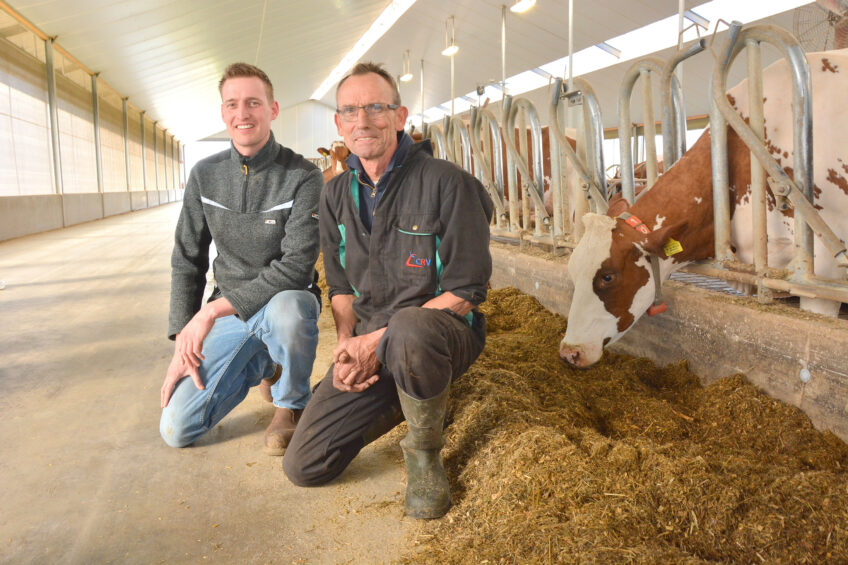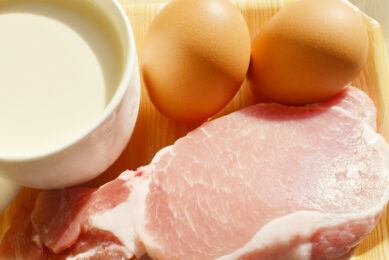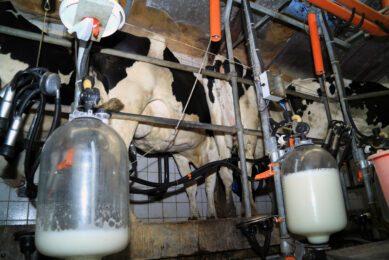Dutch farmer (28): Focus on less antibiotics

A young Dutch dairy farmer says he recognises that continued use of antibiotics on his cows in the future is unviable.
Ivo Hermanussen is just 28 years old and is already in charge of the 200 cow Barendonk Holsteins herd situated at Beers in the east of the Netherlands. Farming with his father Jan, the young farmer recognises the importance of reducing the use of antibiotics yet maintaining a healthy herd. This is even more relevant in the Hermanussen case as they sell breeding stock as well as produce high quality milk.

Strict animal health plan
The herd consists of 200 Holsteins averaging 10,511kgs per cow per year at 3.52% protein and 4.26% butterfat. Even though the herd has continued to expand over the years Ivo would like to expand further, but there are a number of obstacles in his way. Cows are bred to be sold and with that in mind a good herd health status is vital to ensure successful marketing of breeding stock.
Ivo said: “Animal health is very important to us and we see continued use of antibiotics as unviable. On this farm we operate a strict animal health and treatment plan. “Each time a cow has a problem she is assessed and we closely follow the regulations on how to treat her and with which specific medication. “We focus more on prevention rather than treatments to improve animal health and vaccinate for IBR, BVD, Lepto and Salmonella. Hygiene and cleanliness are also very important factors in our efforts to maintain a healthy herd.”

4 milking robots
Since 2010 the Hermanussen family have reduced their bills for antibiotics by 25% thanks to their animal health programme. Plus, the farm now spends around 30% of its health plan budget on prevention rather than treatments. The first free-stall barn on the farm was built in 1979 and expanded once in 1988 and again in 2005 to 135 cubicles. 2 years ago a brand new free-stall barn with another 125 cubicles was added.
Since 2005 there have been 2 Lely robotic milking systems in the first barn and another 2 second-hand robots were added to the new barn in 2016. “The new barn cost us around € 6,000 per cow place including the price of the robots,” said Ivo. “We keep the older cows in the new barn as it has extra comfort for them. The cubicles in all the barns are deep filled with a mix of one kilogram of straw, 2kgs of water and 3kgs of lime. “Good ventilation and available light are also important to our herd and we must allow them outdoors in the summer time for 6 hours per day for 120 days. Following our strict health plan has made us realise that the use of antibiotics on every animal is not necessary. At the moment we are down to using antibiotics on only half the herd which on average means we have reduced antibiotic use by 2 animal doses per day,” he said.

Challenges for Dutch farmers
There are an estimated 1.7 million dairy cows in the Netherlands where 95% of the dairy farms milk record their herds. With this information to hand this has helped reduce the overall use of antibiotics by 65% from 2009 to 2016 there. Jan and Ivo sell their milk to FrieslandCampina and receive an average € 0.365 per litre including taxes. Ivo estimates his costs, including farm labour for him and his father, at € 0.345 per litre.

The Netherlands is a small country stretching to 41,500 square kilometres and home to 18,000 dairy farms making dairy a real intensive sector there. Having so many cows the country adopted its Nitrates Directive in order to comply with EU regulations that govern the amount of phosphates that can be used per farm with a base figure taken from stocking rates in 2015. Dutch dairy farmers are having to move their young stock to other farms in different European countries in order to spread the phosphates quota restriction and comply with the regulations.
Sellling youngstock
Jan and Ivo send half their young stock to a farm in Belgium, close to the French border, to be contract reared in order to comply with their phosphates quota. “We currently have 84 animals in Belgium,” said Ivo. “We send them out there from 8 months old to 1 year and bring them home 2 months ahead of calving. Some of them are sold in Belgium before we need to bring them back and we sell them for around € 1,500 freshly calved.

“The phosphates regulations from the European Commission make it very hard for a young farmer to expand. Land here is around € 70,000 per hectare. We operate around 100 hectares here for growing grass and crops but need more. “I think there needs to be a new system introduced that allows farmers to invest in slurry separation equipment so we can reduce the phosphates applications. The challenges we face today as dairy farmers is achieving a return on our investments whether it be in infrastructure, land or indeed on an animal health plan,” he concluded.
Join 13,000+ subscribers
Subscribe to our newsletter to stay updated about all the need-to-know content in the dairy sector, two times a week.










